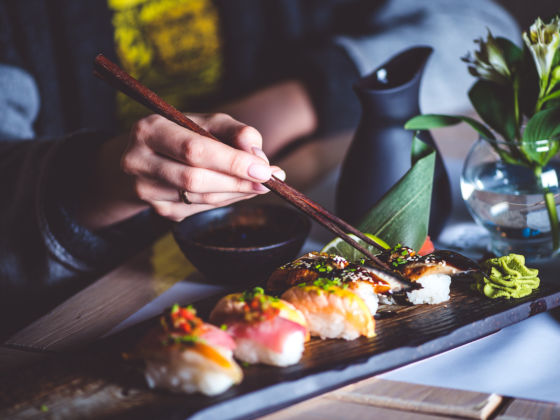The good news: chopsticks are a skill acquired with practice. Soon enough you’ll be grabbing grains of rice and catching flies, but until then, here’s a few easily grasped morsels of advice to get you by.

Tips
Contrary to logic, it’s poor form to chop or stick with your chopsticks. So if that’s the only way you’ll manage to eat, keep it low profile.
Whenever possible, make a side approach. This gives you the best chance to maintain that disappointingly weak white-knuckle grip you thought you had on your food. Keep in mind that eating from a bowl makes this more difficult. Also, the bottom chopstick shouldn’t move. Let the top one do the work.
You’re dealing with a double-edged stick. The higher to the wide end you hold, the more badass stick-cred you get, but also the more crucial control you sacrifice. The lower you slide, the greater likelihood you have of nabbing those nibbles, but also of getting some surreptitious sauce on your hand that you don’t notice until you accidentally wipe it on your face. The best compromise for a gumshoe is to grip two-thirds up the barrel.
Types
The most common chopsticks are made of lacquered wood or metal. They vary in length, and they’re circular or have flat surfaces. Your perfect chopstick would be wooden, short, and with flat surfaces, thus combining the best benefits of friction, control, and maximum surface-area contact. Unfortunately, you’ll rarely have a choice.
So another option is to give yourself one with the most compatible chopsticks for beginners: the free disposable wooden ones you get with takeout or at convenience shops. They’re short, flat-surfaced, and the un-lacquered wood combined with the rough splintery edges you get from pulling them apart provide face-saving friction to help get that food from your plate to your mouth without dropping any on your pants. Throw a few in your pocket or purse and ignore any strange looks, condescending laughs, or unsolicited chopstick tutorials.
Techniques
1. The Golden Dragon
This is nostalgically named for my favorite Chinese joint back home whose many chopstick-challenged patrons often resorted to this method. Consider this technique your chopstick training wheels.
Simply take a napkin, old receipt you found in your pocket, or even the paper packaging of your disposable wooden sticks, and fold it into a small rectangle with some width. Place the wedge somewhere around the middle of your sticks. Then take a rubber band and wrap it around until the wedge is tightly secured in place. Now all you have to do is squeeze the sticks together to pick up your food; no complicated finger maneuvering required!
Disclaimer: This method will make you look like a foreign idiot.
2. The Scholar
Weighing in as the most widely accepted chopstick technique, The Scholar relies on the top stick being held like a pencil; resting between your middle and pointer finger and extending up over your lowest pointer knuckle. The bottom stick runs along the webbing between your thumb and pointer and lies delicately on the upper broad side of your ring finger.
3. The Darth Vader
This is the rough, un-honed apprentice of The Scholar that won’t subscribe to orthodox techniques. The basic hand positioning is the same, though rather than resting, both sabers should have contact with your fingertips: the top one with your middle finger, and the bottom with your ring finger, leaving your pointer finger free to direct the force. The Darth Vader offers powerful control options and may eventually become the master.
Etiquette
Finally, each country you visit will have some unwritten etiquette rules involving the sticks. One common tenet is to not leave your chopsticks standing upright in your bowl, as this is often how food or burning incense sticks are offered to ancestors. Do a quick Wikipedia search, consult a guidebook, or better yet, ask someone, before you go offending not only the living locals, but also their deceased.